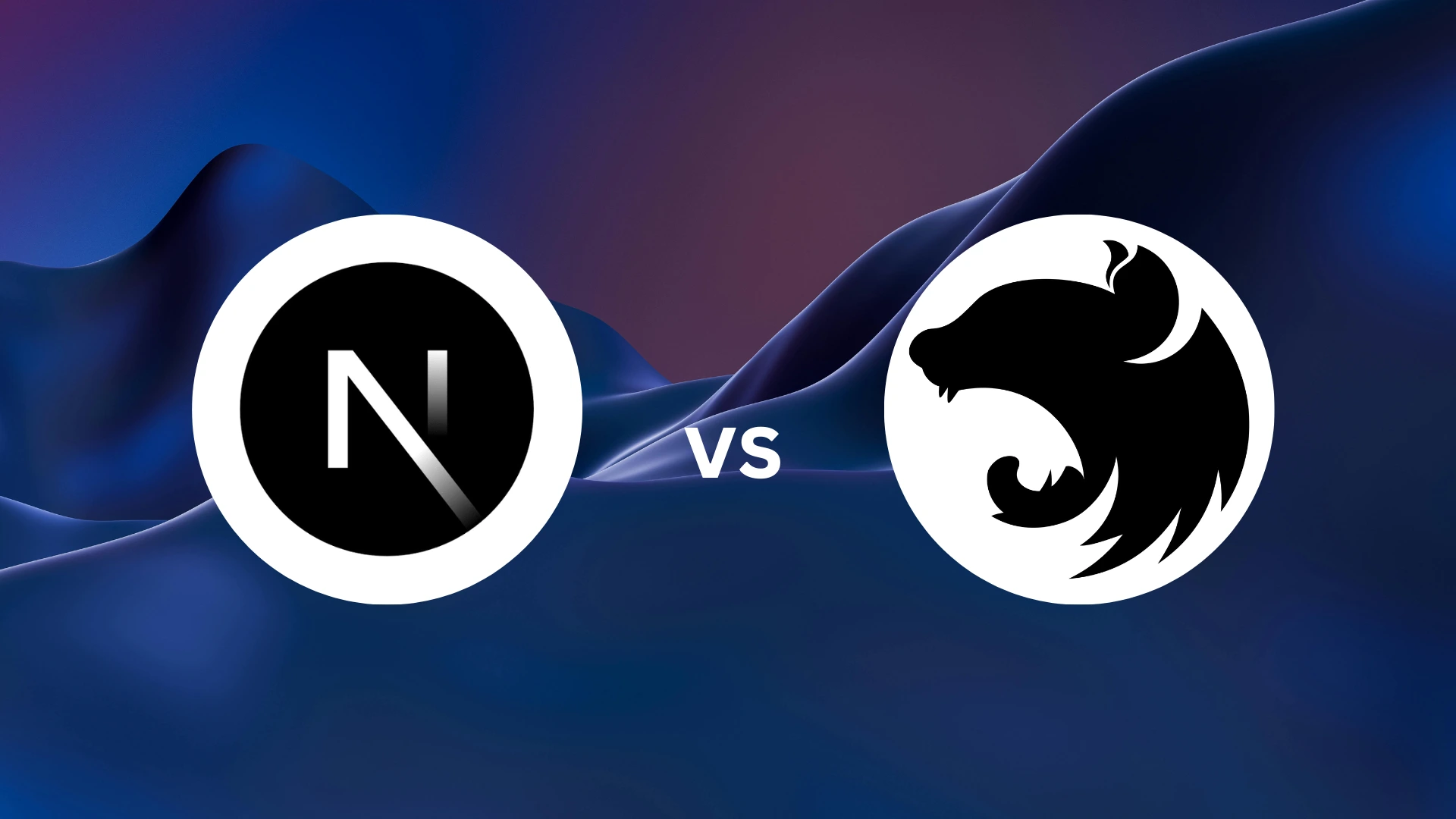Back to all Articles
NestJS vs. NextJS: Differences and Use Cases from a CTO’s Perspective
Updated:
Thu, Apr 17
Reading time: 8 minutes

People often confuse NestJS and Next.js, because the names are very similar. However, the truth is, these two frameworks couldn’t be more different in how they’re used.
I’ve been working in software development for over 20 years, and I’ve seen firsthand how important it is to choose the right framework for the project. Choose the wrong framework, and you’re setting yourself up for a headache in the future.
That’s why I think this comparison matters. If you’re working on a new project and wondering which one to go with, let’s break it down so you can make an informed decision.
This is for anyone making tech decisions. From CTOs, developers, architects to startup founders trying to figure out their stack. I’ll walk you through how both NestJS and NextJS frameworks work, their biggest differences, and when you should choose one over the other.
What is the NestJS Framework?
NestJS is a solo backend framework. It is a Node.js framework designed to make server-side development cleaner and more efficient. Inspired by Spring Boot, NestJS is built with a strong architectural foundation. It is an excellent choice for both monolithic and microservices architectures. If I had only three words to describe NestJS, they would be: structured, scalable, and easy to maintain.
NestJS runs on TypeScript. It allows developers to share validation logic, business rules, and even entire data models between the frontend and backend.
That means fewer inconsistencies, less duplicate work, and a smoother development process overall. Plus, it comes with automatic Swagger documentation and a strong built-in testing ecosystem. So everything stays well-documented and easy to debug.
That means fewer inconsistencies, less duplicate work, and a smoother development process overall. Plus, it comes with automatic Swagger documentation and a strong built-in testing ecosystem. So everything stays well-documented and easy to debug.
Generally, CTOs choose NestJS for RESTful APIs, GraphQL APIs, microservices, real-time and enterprise applications.
What is the NextJS Framework?
Next.js is both a backend and frontend framework. It is a React-based framework designed to make frontend development faster and SEO-friendly. Next.js provides server-side rendering (SSR) and static site generation (SSG). It makes web pages load faster and improves their search engine visibility.
One of Next.js’s key advantages is its hybrid rendering capabilities. It allows developers to decide (per page) whether they want static generation, server-side rendering, or client-side rendering.
This makes it an ideal solution for projects that need a balance of speed, interactivity, and real-time updates. Examples include e-commerce platforms, content-heavy websites, and dynamic dashboards.
This makes it an ideal solution for projects that need a balance of speed, interactivity, and real-time updates. Examples include e-commerce platforms, content-heavy websites, and dynamic dashboards.
Next.js is mostly frontend-focused, it also comes with built-in API routes. This means you can throw in some backend logic without setting up a whole separate backend. It’s not a full-on backend framework like NestJS, but for smaller backend tasks it does the job just fine.
Architectural Differences Between NestJS and Next.js
NestJS and NextJS serve completely different purposes—even though their names sound kinda similar. So let’s break down the architectural differences.
NestJS is strictly a backend framework. If you need to handle complex backend logic, REST APIs, GraphQL APIs, or real-time WebSockets, NestJS is built exactly for that.
The key advantage of NestJS’s architecture is its modularity. You start by structuring your app into feature-based modules, which keeps everything clean and makes it easy to scale. Plus, it’s fully compatible with dependency injection. This makes backend development more organized and testable.
You can start with a monolithic application and easily transition into microservices later without rewriting everything. That’s a big advantage for companies that want to scale over time without unnecessary refactoring.
Nest.js is well-equipped for writing tests, whether for endpoints, unit tests, or integration tests. Everything is already set up for that. A lot of these concepts originally came from Spring and Java. Early microservices were often built in Java using Spring Boot, which is an ideal example of this approach.
The key advantage of Nest.js is that you’re using the same technology for both the backend and frontend - JavaScript. This allows easy code-sharing between the frontend and backend, which is exactly what we did in our “Delivery Service App” project.
Now, Next.js is a completely different beast. It’s a front-end framework with backend capabilities designed for React-based applications. It’s all about performance, server-side rendering (SSR), static site generation (SSG), and SEO optimization.
Next.js is designed to render web pages efficiently. It lets developers decide whether to pre-render pages (SSG), generate them dynamically on the server (SSR), or just keep everything client-side rendered (CSR). Next.js is a go-to choice for projects where speed and SEO matter.
Next.js’s architecture includes built-in API routes. This means you can write some backend logic within a Next.js project without needing a separate backend framework.


How NestJS and Next.js Handle Integrations
When it comes to connecting with other systems, NestJS and Next.js take very different approaches. NestJS is designed for API communication and real-time connections. Next.js focuses on frontend performance and API routing, often in a serverless environment.
NestJS communicates using REST APIs, but it also supports other protocols:
- NestJS provides a structured way to build RESTful services, making API management clean and scalable.
- WebSockets – Unlike REST, which requires a request-response cycle, WebSockets allow continuous, bidirectional communication. This is crucial for live chat apps and real-time dashboards.
Next.js focuses on efficient data fetching and cloud-based deployments. Next.js allows developers to create simple API endpoints inside the same project. This is a good match for things like form submissions, authentication, and fetching data from an external CMS or database.
However, these API routes aren’t a full replacement for a dedicated backend like NestJS. Next.js is built to work with cloud platforms like Vercel, AWS Lambda, and Google Cloud Functions. So, API routes can be deployed as serverless functions.
However, these API routes aren’t a full replacement for a dedicated backend like NestJS. Next.js is built to work with cloud platforms like Vercel, AWS Lambda, and Google Cloud Functions. So, API routes can be deployed as serverless functions.
💡 Need help with your NestJS Project?
Reach out to our experts today!
Reach out to our experts today!
Development Workflow with NestJS and NextJS
One of the biggest advantages of NestJS is that it’s built on JavaScript (or TypeScript). This means developers can use the same language for both backend and frontend. This simplifies development, especially when working in full-stack environments. It reduces the need to switch between different programming languages.
Instead of splitting frontend and backend tasks across many developers, a single developer can own a feature end-to-end. This means they get business requirements directly and don’t have to coordinate with another person.
In our project for IKEA, we took full advantage of this by creating a unified validation system that worked across both the frontend and backend. Domain classes and models were written once and reused everywhere. This significantly cut development costs since we weren’t writing duplicate logic in two separate places.
For teams following Domain-Driven Design (DDD), NestJS makes life easier by allowing developers to encapsulate logic within domain models or classes that can be used both in the frontend and backend. This means less duplication, faster implementation, and lower long-term costs.
Another big advantage is that working with NestJS helps JavaScript developers become full-stack engineers more easily. Since everything runs on JavaScript/TypeScript, frontend devs don’t need to learn Java or another backend language to start working on tasks. This results in faster onboarding and a better understanding of the entire application.
From a project management perspective, this also reduces friction. A single developer can take on a full feature (from frontend to backend) without relying on multiple people. This improves prevents communication bottlenecks, API mismatches, and speeds up development.
Next.js offers full-stack capabilities. Developers can handle backend logic, API routes, and data fetching within the same project. However, the way developers work with Next.js varies depending on the deployment strategy and the needs of the application.
Next.js is often used to build serverless applications, where backend logic is split into serverless functions deployed on platforms like Vercel, AWS Lambda, or Google Cloud Functions.
This allows developers to scale their backend automatically without managing a dedicated server. That said, Next.js itself isn’t inherently serverless—it can also be deployed traditionally on a backend server.
This allows developers to scale their backend automatically without managing a dedicated server. That said, Next.js itself isn’t inherently serverless—it can also be deployed traditionally on a backend server.
Choosing the Right Framework for Your Project
By now, it should be clear that NestJS and Next.js are built for completely different purposes. If you’re choosing between them, it’s not about which one is better—it’s about what your project actually needs.
If your focus is backend development, scalable APIs and microservices - NestJS is the right choice.
If server-side rendering (SSR), static site generation (SSG), and SEO optimization are critical, Next.js is the way to go.
But you can also using both - NestJS as the backend, handling APIs and business logic, and Next.js as the frontend.
At Ulan Software, we specialize in developing applications using NestJS and Next.js. We help businesses design backend architectures that are modular, testable, and future-proof.
We’ve worked with startups and enterprise clients, helping them optimize their development processes, reduce costs, and accelerate time to market. If you're considering NestJS for your next project, let’s talk!
Wojciech Andruszków
Wojciech is experienced CTO. Over the past 15 years he has led high-profile projects for major financial institutions such as Standard Chartered, UBS, RBS, and NatWest, managing projects worth over £1 billion.
Table of Contents:
What is the NestJS framework?
What is the NextJS framework?
Architectural differences between NestJS and Next.js
How NestJS and Next.js handle integrations
Development workflow with NestJS and NextJS
Choosing the right framework for your project
Recommended Articles
Thu, Nov 20
Top 15 UX Tips to Improve Conversion Rates in Travel Booking
Improve travel booking flow conversion with 15 proven UX tips. Learn how mobile design, pricing clarity, speed, and smart flows reduce friction and lift bookings.
Mon, Nov 17
What to Look for in Enterprise Booking Software?
Learn what to look for in enterprise booking software: key features, integrations, security, and data to guide your 2025 selection.
Thu, Nov 6
Best White-Label Booking Software in 2025
Discover the best white-label booking software in 2025 for travel, appointments, car rental and events, with pros, cons, pricing and real user reviews.


